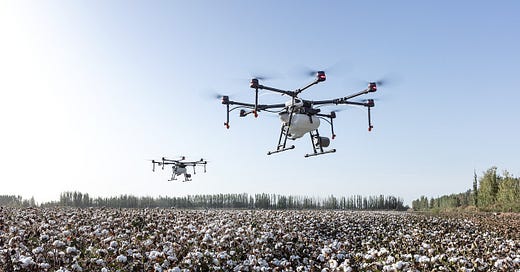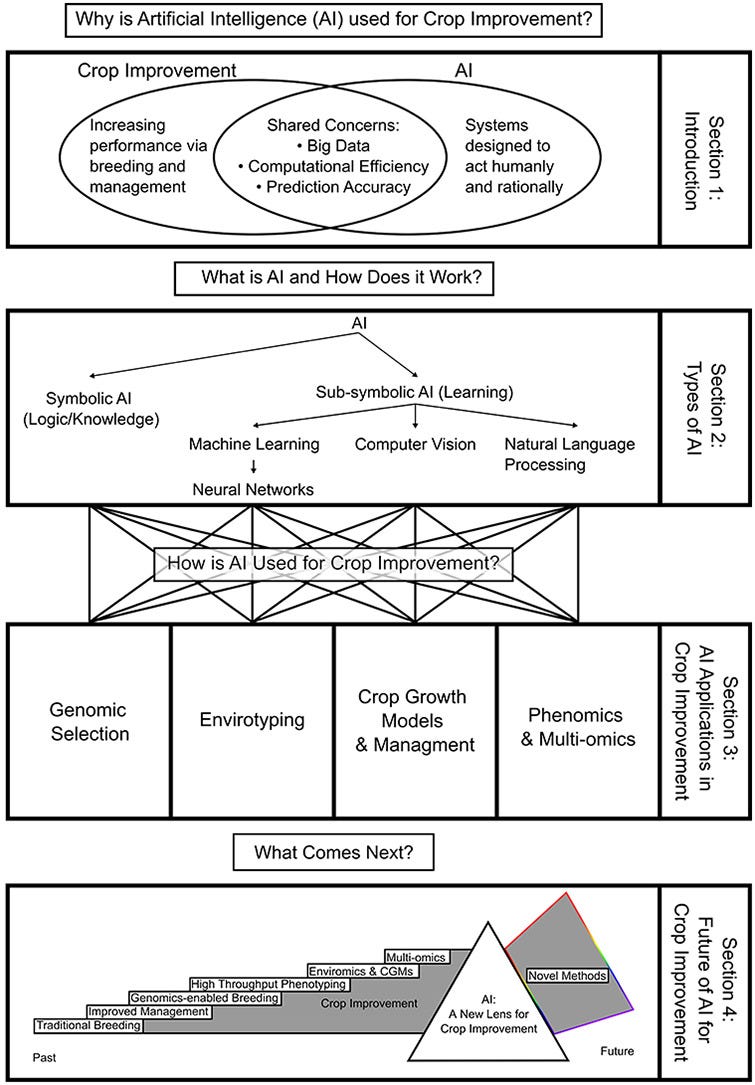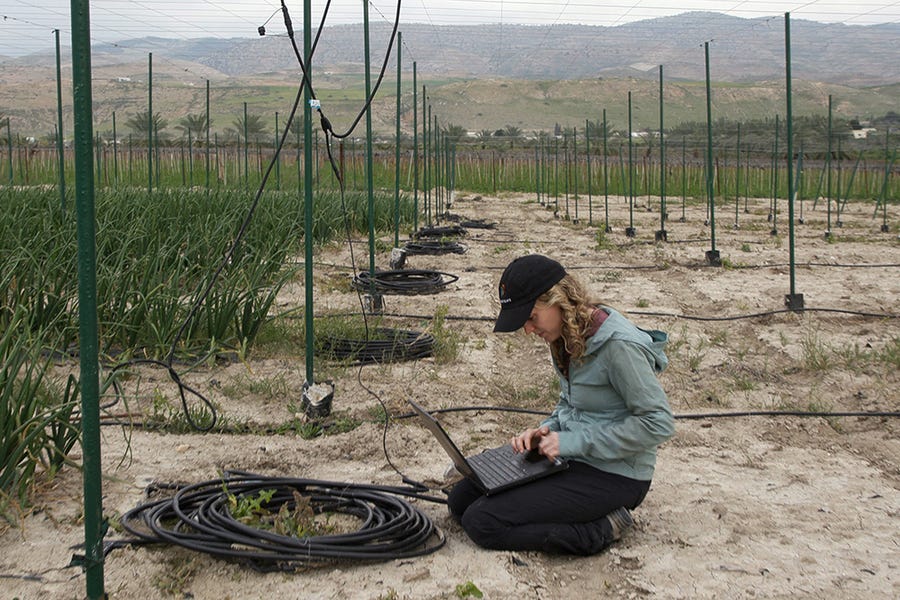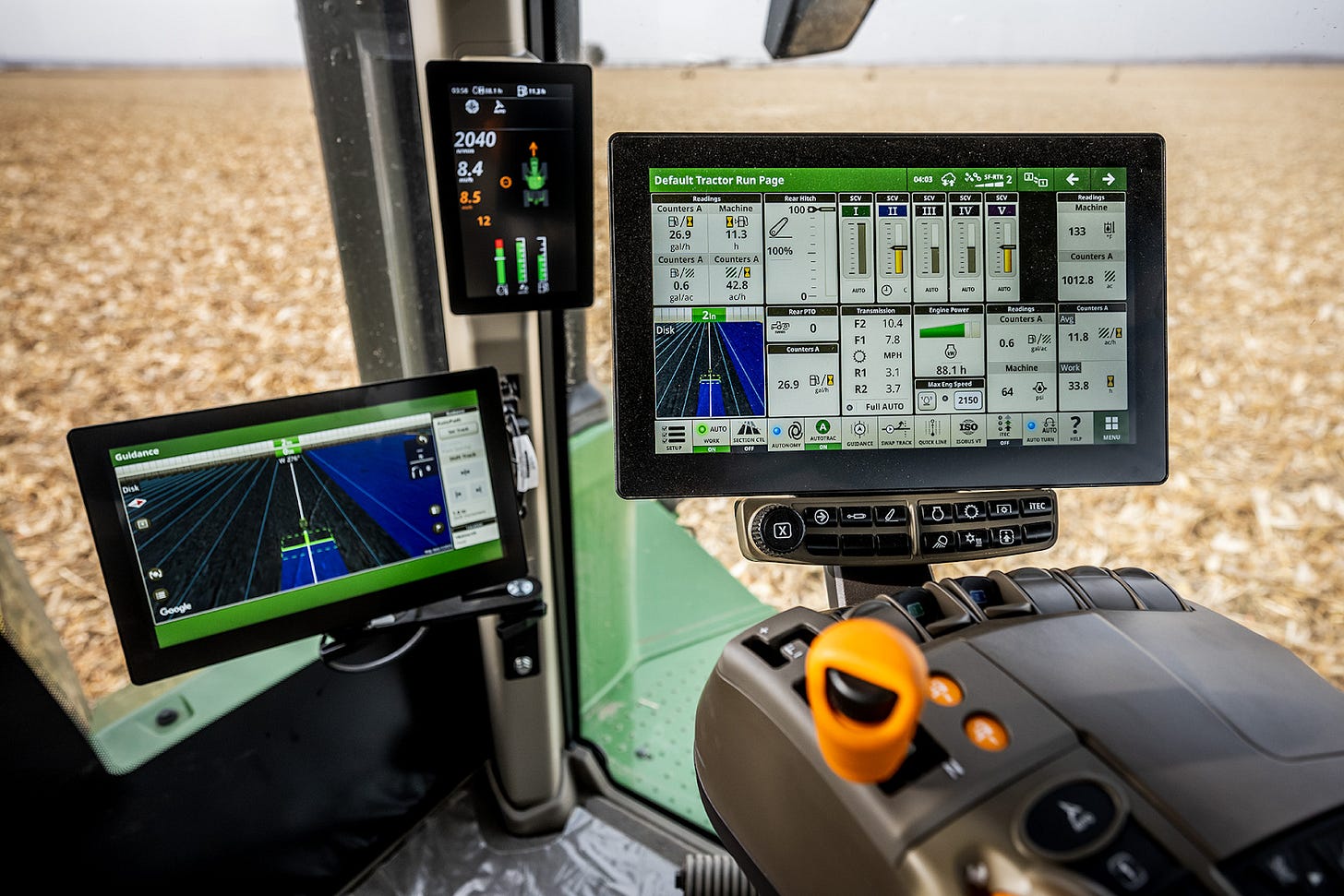Why AI Will Become as Essential as Seed and Soil in Modern Agriculture
As all of agribusiness faces tighter and tighter profit margins, artificial intelligence will play a crucial role in recapturing dollars, making the entire supply chain more resilient and efficient.
Too long, didn’t read:
Artificial intelligence (AI) is sophisticated technology, but it’s incredibly easy to use. You can start using it to assist you in small tasks today–there’s no need to wait until new AI-enabled tools specific to agriculture are available.
Agriculture is not immune to AI’s effects. In fact, AI will likely impact every part of the ag supply chain eventually. From crop breeding to pest control, AI can process massive datasets to optimize decisions, speeding up innovation and increasing efficiency.
With agriculture being one of the slowest adopters of certain (but certainly not all) aspects of technology, making use of AI now will put you ahead of the curve and give you a better chance of future-proofing your agribusiness.
What Even Is AI?
AI, or artificial intelligence, is essentially machines that can think, or at least act like they do, by learning from data and adapting over time. Rather than relying on rigid programming, AI systems learn from past experiences, observe current trends, make predictions, and refine their outputs through continuous learning. In many industries, this could look like an AI tool analyzing patterns to determine the best time for a specific action or optimizing a process based on ever-evolving data. Think of AI as a really sharp assistant who’s always on the clock, refining its approach with each new piece of information. AI relies on vast amounts of high-quality data to train its models, uncovering insights that might elude human perception. The real potential of AI is that it can handle tasks that are too complex, too time-consuming, or too unpredictable for us to manage on our own, allowing us to focus on what really matters while it continuously gets better at what it does.
Beneath the surface, AI is powered by a combination of complex algorithms, neural networks, and statistical models. This is where it gets a bit nerdy, but stick with me. At its core is a concept called machine learning, where the system identifies patterns in massive datasets and refines its predictions over time. More advanced systems rely on deep learning, which simulates human brain structures with layers of artificial neurons that continuously tweak and adjust based on new data. These systems use algorithms like gradient descent to minimize errors by adjusting each neuron’s weight and bias after each data pass. It’s like tuning a piece of equipment until it runs perfectly, except AI does this automatically, thousands of times per second. Some models even use convolutional neural networks (CNNs) to analyze images, which helps drones identify pests or detect crop stress, while recurrent neural networks (RNNs) handle sequential data like weather patterns to improve long-term yield forecasts. The math behind it–matrix multiplication, activation functions like ReLU (Rectified Linear Unit), and stochastic gradient descent–is complex, but the result is simple: AI systems that get smarter, faster, and more accurate the longer they run.
Moore’s Law tells us that computing power doubles every two years while costs drop. Some people question whether this can keep happening since computers are becoming so powerful that it’s hard to keep adding more power to a single processor. Isn’t it incredible that technology is advancing so quickly we’re actually reaching the limits of what a single chip can handle? What once required a supercomputer now runs on a smartphone, and AI is following that same exponential curve into production, becoming smarter, faster, and more affordable.
As with any emerging technology, the challenge isn’t just about what AI can do. It’s about how we, as an industry, can actually integrate it into everyday practices. While the power of AI is evident, there are still significant hurdles to overcome before it’s widely accessible and beneficial for all types of operations.
Take something I did on my laptop yesterday, for example. I wanted to create a simple Excel macro–something that might take me an afternoon, if not longer, if I could even code in VBA (Visual Basic for Applications, or the programming language used to write macros in Excel) to begin with. But with AI’s help, I knocked it out in about 20 minutes with no prior experience coding in VBA. (Yes, you read that italicized part correctly.) While it was a small task, it really highlights how AI can streamline even routine work and make us that much more efficient–to say nothing of enabling us to leapfrog by giving us access to tools we didn’t previously have access to.
So, the question becomes: is agriculture truly ready to embrace AI, or are we still in the early stages of figuring out how to unlock its full potential?
AI is Ripe for Agriculture, but Is Agriculture Ready to Reap Its Benefits?
AI is certainly making its way into agriculture, but it’s not being rapidly or universally adopted at the individual farm level. While AI technology is evolving quickly and seeing adoption on large farms, research facilities, and by agricultural technology companies, smaller and even medium-sized farms may not yet be realizing the full benefits–or any at all.
The reality is that the widespread integration of AI into everyday farming tasks is still in its early stages for virtually all growers, if it has occurred at all. Will AI advance so quickly that it gets integrated into the tools farmers already use, without them ever interacting directly with the raw AI technology themselves? Highly likely if not probable. The question isn’t really if AI will change farming, but how soon it will become accessible and practical for everyone, and what level of accessibility farmers will have versus simply reaping the benefits of better products and services. For those who actively engage, how quickly will they be able to adapt, and will they be prepared to take full advantage of the technology as it evolves? While it’s true that AI is evolving quickly and could revolutionize certain aspects of farming, other growers will decide the costs aren’t worth the benefits to engage with AI themselves. But even these will one day be affected–and hopefully aided–by AI.
To those who are hesitant to dive in themselves: I encourage you to engage with currently available AI tools. Pick one of the dozen free applications, like ChatGPT. If this one is your choice, you’ll immediately be staring at a question when you visit the link: “What can I help with?” I urge you to take its advice and “Ask anything” by typing your question in the box below. Try asking it for the most recent closing price for the December corn futures contract traded on the Chicago Mercantile Exchange. Is it right? Is it wrong? If it’s wrong, tell it it was wrong. Ask it to try again. Maybe add a link to the website and tell it to carefully analyze the site before answering. If it’s wrong again, ask it how to craft a better question that minimizes its chances of a hallucination, or an incorrect answer. If it’s right, positively reinforce it; that’s how it learns. While I don’t think you’ll find this is the best use of AI, it will help you understand how it thinks and how to prompt it.
Accelerating Crop Breeding through AI-Assisted Data Analysis
One area where AI has serious potential is crop breeding. Traditional breeding cycles take years–cross this, plant that, wait and see. But AI can process massive datasets, including plant genetics, soil profiles, weather patterns, and yield histories, to predict which crosses are worth pursuing. It would be like having a plant breeder who never stops working and learns from every outcome. For the commodity side of things, this means faster development of hybrids and varieties tailored to regional performance, disease resistance, and yield stability. Companies could also use AI-driven phenotyping to analyze thousands of genetic markers and their accompanying physical expressions in days rather than months, identifying traits that might have been overlooked using traditional methods. Or, imagine selecting seeds not just based on visible traits but on their predicted ability to handle drought stress, resist fungal diseases, or convert sunlight into energy efficiently before they even hit the field for trials.
Traditional breeding takes time. It often relies on phenotypic selection, which can be time-consuming and influenced by environmental factors and even factors related to labor. You plant, observe, and make selections, but the environment plays a huge role in how those plants perform, which can make it tough to pinpoint the best genetics. With AI, breeders could perform genomic selection by analyzing huge datasets of genetic information to predict the performance of various genotypes. Machine learning models can process these datasets to identify patterns and associations between genetic markers and desirable traits like drought tolerance or disease resistance. If large-scale breeding programs could find a way to get this done, what could previously take years might be shortened to a single season.
Researchers at Iowa State University back this up, saying that the technology is primed to be used for crop improvement, but many just don’t know where to start. As an answer to that charge, they created an excellent overview of how AI can be used to accelerate crop improvement that defines AI and explains its potential usage.
AI-Driven Precision: Minimizing the Unknown Variables
Planting is another area where AI could really change the game. It moves beyond autosteer and variable rate plating into deeper decision-making. AI could be used to analyze soil texture, last season’s yield data, and weather predictions to recommend where certain hybrids should go, how deep to plant, and how many seeds to drop. Instead of treating a 160-acre field as one big unit, AI systems break it down into hundreds or thousands of “microfields,” each getting a tailored planting strategy. In corn, for example, hybrids with strong stalks might be planted in areas of a field and soils prone to wind damage, while higher-yielding but weaker-stalked hybrids are placed in more sheltered spots. Obviously, there are equipment-based obstacles to such a strategy, but this practice is already occurring today, albeit in a less sophisticated sense. Think about it. How many farmers get planting recommendations from their agronomist who went through a similar process either manually or with the help of precision agriculture software? Put simply, AI could automate this process and enable it on a much larger scale.
AI could also help optimize timing in a way that takes the guesswork out of planting. The technology could predict the best planting window based on upcoming weather and soil temperatures, taking the unknowns out of the equation to the extent possible (after all, AI still can’t tell the future). Fertilizer applications could also become more precise. Instead of broad, season-long application plans, AI-driven nitrogen management systems could use satellite imagery and in-field sensors to track biomass development and chlorophyll levels in real-time, adjusting recommendations as the crop grows. It’s the difference between spoon-feeding nutrients when the plants need them most. And again, this is nothing new, but AI could take these practices to the next level.
It should come as no surprise that pest control is yet another factor that could benefit from AI’s help. (By now, you might be like me and wondering what area of crop production can’t benefit from AI!) AI can analyze drone or satellite images to detect early signs of infestation–not just identifying damaged areas, but recognizing specific patterns linked to different pests. Systems could even integrate with autonomous sprayers that target pests only where they’re detected, reducing chemical use and minimizing resistance buildup. Instead of blanket applications, imagine a sprayer treating only affected plants with pinpoint accuracy. Oh, wait, that already exists and is using early generation AI technology. If that’s the state of the art today, think about what will be possible tomorrow.
Our last newsletter covered our need to preserve water sources in-depth, as water scarcity is not only a global issue, but one that we’re staring down here in large portions of the U.S. Automating and optimizing irrigation scheduling is yet another way we can secure our water future. By blending weather forecasts, soil moisture data, and evapotranspiration rates, AI could optimize irrigation schedules to avoid over- or under-watering, allowing for every drop to count. Systems could be configured to combine satellite imagery with thermal sensors to detect heat stress before it’s visible to the eye, triggering irrigation adjustments automatically.
In the Jordan Valley, researchers from MIT’s Global Engineering and Research (GEAR) Lab have developed a low-cost precision irrigation controller designed to make advanced technology accessible to small-scale farmers. This AI-driven system automates water delivery by analyzing real-time data on soil moisture, weather patterns, and crop needs, ensuring each section of the field gets the right amount of water at the right time. At one Moroccan test site, the technology reduced water consumption by 44 percent as compared to neighboring farms using traditional drip irrigation. What makes this system particularly farmer-friendly is that it allows growers to decide how much automation they want to use. They can either let the AI handle everything or adjust schedules manually based on their own experience and preferences. This flexibility helps farmers blend technology with their own instincts, creating a balance between modern innovation and traditional know-how.
What’s especially powerful about this approach is how it shifts the balance of agricultural technology. Precision irrigation has often been a tool reserved for the larger, better-funded operations many of us are more familiar with or grew up on. But this system proves that AI can empower smaller farms, too. It’s a reminder that the future of farming isn’t just about high-tech machinery or vast data networks–it’s about making those innovations accessible and adaptable to the people who need them most. By giving farmers control over the level of automation used, the technology becomes a partner rather than a replacement for their expertise. When AI supports small-scale growers this way, it doesn’t just improve individual farms; it strengthens food security and reliability for entire communities. If this is possible on smallholder operations in some of the poorest, least connected and least technically sophisticated parts of the world, think about the scale of water reductions that can be delivered on farms here in the U.S.
AI in Market Forecasting and Supply Chain Optimization
Commodity price forecasting has always been a blend of data and gut instinct, but AI could bring unprecedented precision. Advanced models can pull in the usual suspects of global weather patterns and historical yield data along with shipping logistics and even trade policy chatter to better predict market movements. By integrating AI with market data, farmers could more effectively anticipate price fluctuations and make better decisions about when to sell, when to store, and how to hedge against potential downturns. For instance, an AI-powered model might tell a farmer that the price of corn traditionally peaks in six weeks based on historical trends, indicating the time to clean out bins to maximize profit is close at hand. This level of precision would take much of the guesswork out of commodity markets, offering strategic insight that extends beyond traditional methods. How accurate are those tools today? Many would argue a farmer’s gut may still be more accurate, and I probably wouldn’t disagree. But I would argue that any additional insight is helpful, and if it removes emotion from the marketing process–ironically enabling a farmer to follow his gut sooner, it will lead to better outcomes.
Beyond forecasting prices, AI could revolutionize how agricultural products are transported from farm to table. The supply chain is one of the most complex and costly aspects of agriculture, and inefficiencies in transportation, storage, and distribution can eat into profits. AI could help streamline this by predicting demand shifts and optimizing logistics at every stage. AI systems could track and predict potential disruptions in the supply chain, whether it’s bad weather, port congestion, or labor shortages, and reroute shipments or adjust schedules in real time. These systems could forecast fuel price fluctuations or delays caused by natural disasters, allowing traders and transporters to adapt quickly.
Grain storage facilities could use AI to predict spoilage risks based on temperature, humidity, and airflow. By adjusting ventilation and moving grain proactively, losses that would traditionally go unnoticed until too late could be prevented. These improvements will increase efficiency, reduce waste, and help maintain product quality. AI could also be integrated into processing plants to even more effectively sort, package, and manage inventory (tasks that are already aided by a version of machine learning but could be made even more effective with today’s AI technology). For example, AI-driven sniffers could even detect spoilage in grain more effectively. This would represent a significant step forward in reducing human error and ensuring that products leaving storage facilities are each optimized for sale.
Another exciting use case for AI is in the area of food waste. From better storage practices to more efficient transportation routes, AI could ensure that food reaches consumers faster, fresher, and with less loss along the way. Imagine a system that predicts spoilage in real-time and suggests adjustments to transportation routes, ensuring that perishable goods like fruit and vegetables stay fresh. It would be a win for the entire supply chain.
The Downside of AI and Digital Ag
If you’re reading this and thinking all of it sounds great, but what about when it fails, you’re not alone. Reliability of AI systems is and will be a concern, considering its dependence on the internet, satellite data, and cloud processing, meaning a temporary connectivity issue could cause a temporary halt to work. In theory, having backups like that don’t rely on those things would be really smart. But who has the resources for redundant equipment? Sure, we’d also like to have backups for a million reasons. For example, a mechanical-plate planter is something many farmers would love to have sitting around their equipment yard, but few still do. Same with a tractor that doesn't require a Deere technician to come out if it breaks down. Few have that either.
I could go on, but the real issue isn’t just the possibility of over-reliance on AI–it’s digital agriculture at-large. Every piece of equipment requires investment, upkeep, and storage, and in a business with tight margins, most farmers simply can’t afford to keep a second set of tools on standby just in case. So while AI is valuable, the real problem isn’t just making sure there are backups, it’s that we need to rethink how digital agriculture can be built to keep farms running without requiring an expensive safety net that most can’t afford.
AI is Here to Stay–How Can You Start Getting to Know It?
AI is already reshaping the way agriculture operates, and it’s happening faster than many expected–and in many cases, without much fanfare. Those who lean into this technology now will lead the charge, setting the pace for what modern agriculture looks like. But the truth is, AI isn’t an all-or-nothing leap. Everyone in the supply chain can start by using one tool at a time. Farmers might begin with AI-guided decision-making using one of the free platforms. Seed companies can take an extra step and accelerate breeding pipelines. Researchers can harness AI to analyze massive datasets faster and more accurately. CPG companies and traders can begin to leverage AI for supply chain forecasting, ensuring they’re sourcing from the most efficient, reliable, and resilient producers. And anyone can simply use it to help shave a few minutes off each day by using it to aid in mundane tasks like answering email. It’s that easy to get started.
The point is just that: start somewhere. Every incremental step builds an advantage–more efficiency, better yields, lower input costs, smarter marketing decisions, and a more resilient supply chain from seed to shelf. And here’s the thing–when more parts of the industry embrace AI, data grows more robust, algorithms improve, and everyone benefits from stronger, more reliable insights. It’s a rising tide that lifts the entire sector.
So don’t wait to see if AI works. It already does. The only thing left to decide is whether you’ll lead the way. The companies, researchers, farmers, and organizations that figure out how to make it work for them first are the ones that will still be thriving, shaping markets, and feeding the world for generations to come.
Recent Articles
Beyond exports: How ethanol keeps sorghum farmers thriving in uncertain times in Kansas Farmer
If you haven’t already, check out our previous newsletters.
About Serō Ag Strategies
At Serō Ag Strategies, we bridge farmers and supply chain partners by transforming complex agricultural data and policy into actionable insights. Our approach combines multinational expertise with boutique consulting’s personal touch, specializing in sustainability and economic analysis that drives strategic innovation.
Click here to learn more about Serō Ag Strategies.








